Economics Assignment: Singapore Economic Analysis and Report
VerifiedAdded on 2023/06/10
|12
|2949
|362
Report
AI Summary
This economics report provides a comprehensive analysis of Singapore's economic performance over the past decade, focusing on production output, labor market dynamics, and price level analysis. The report examines key economic indicators such as GDP growth, unemployment rates, and inflation, highlighting the impact of global events like the Global Financial Crisis (GFC) and governmental policies. It details the growth of industries, including finance, logistics, and manufacturing, and their contributions to Singapore's economic expansion. The report also explores fluctuations in GDP, unemployment, and inflation, discussing factors influencing these trends, such as international trade, fiscal policies, and labor market conditions. The analysis includes figures and data from sources such as Tradingeconomics.com to support the findings. The report concludes with an overview of the economy's resilience and the importance of addressing wealth disparity to ensure future economic stability.
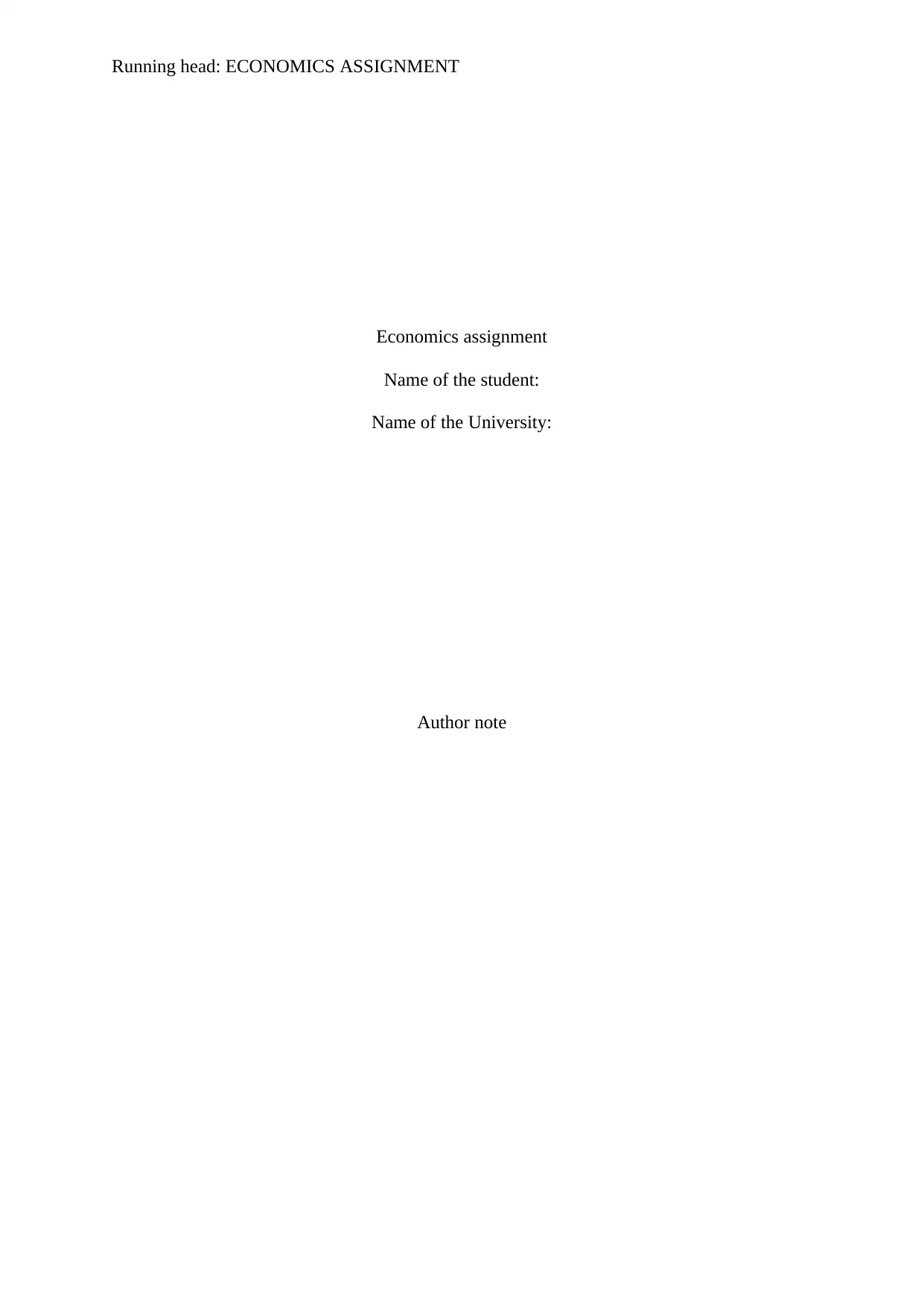
Running head: ECONOMICS ASSIGNMENT
Economics assignment
Name of the student:
Name of the University:
Author note
Economics assignment
Name of the student:
Name of the University:
Author note
Paraphrase This Document
Need a fresh take? Get an instant paraphrase of this document with our AI Paraphraser
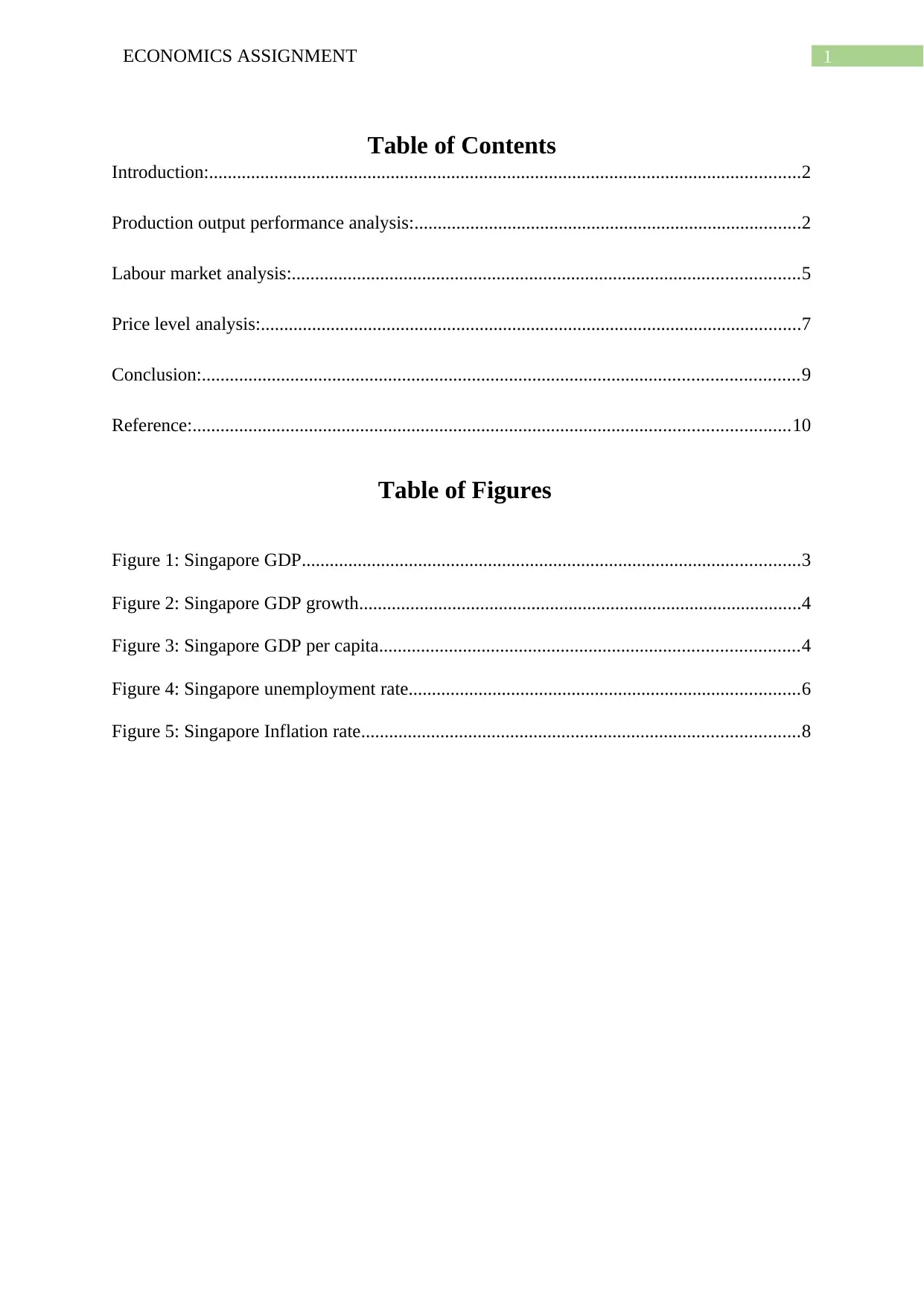
1ECONOMICS ASSIGNMENT
Table of Contents
Introduction:...............................................................................................................................2
Production output performance analysis:...................................................................................2
Labour market analysis:.............................................................................................................5
Price level analysis:....................................................................................................................7
Conclusion:................................................................................................................................9
Reference:................................................................................................................................10
Table of Figures
Figure 1: Singapore GDP...........................................................................................................3
Figure 2: Singapore GDP growth...............................................................................................4
Figure 3: Singapore GDP per capita..........................................................................................4
Figure 4: Singapore unemployment rate....................................................................................6
Figure 5: Singapore Inflation rate..............................................................................................8
Table of Contents
Introduction:...............................................................................................................................2
Production output performance analysis:...................................................................................2
Labour market analysis:.............................................................................................................5
Price level analysis:....................................................................................................................7
Conclusion:................................................................................................................................9
Reference:................................................................................................................................10
Table of Figures
Figure 1: Singapore GDP...........................................................................................................3
Figure 2: Singapore GDP growth...............................................................................................4
Figure 3: Singapore GDP per capita..........................................................................................4
Figure 4: Singapore unemployment rate....................................................................................6
Figure 5: Singapore Inflation rate..............................................................................................8
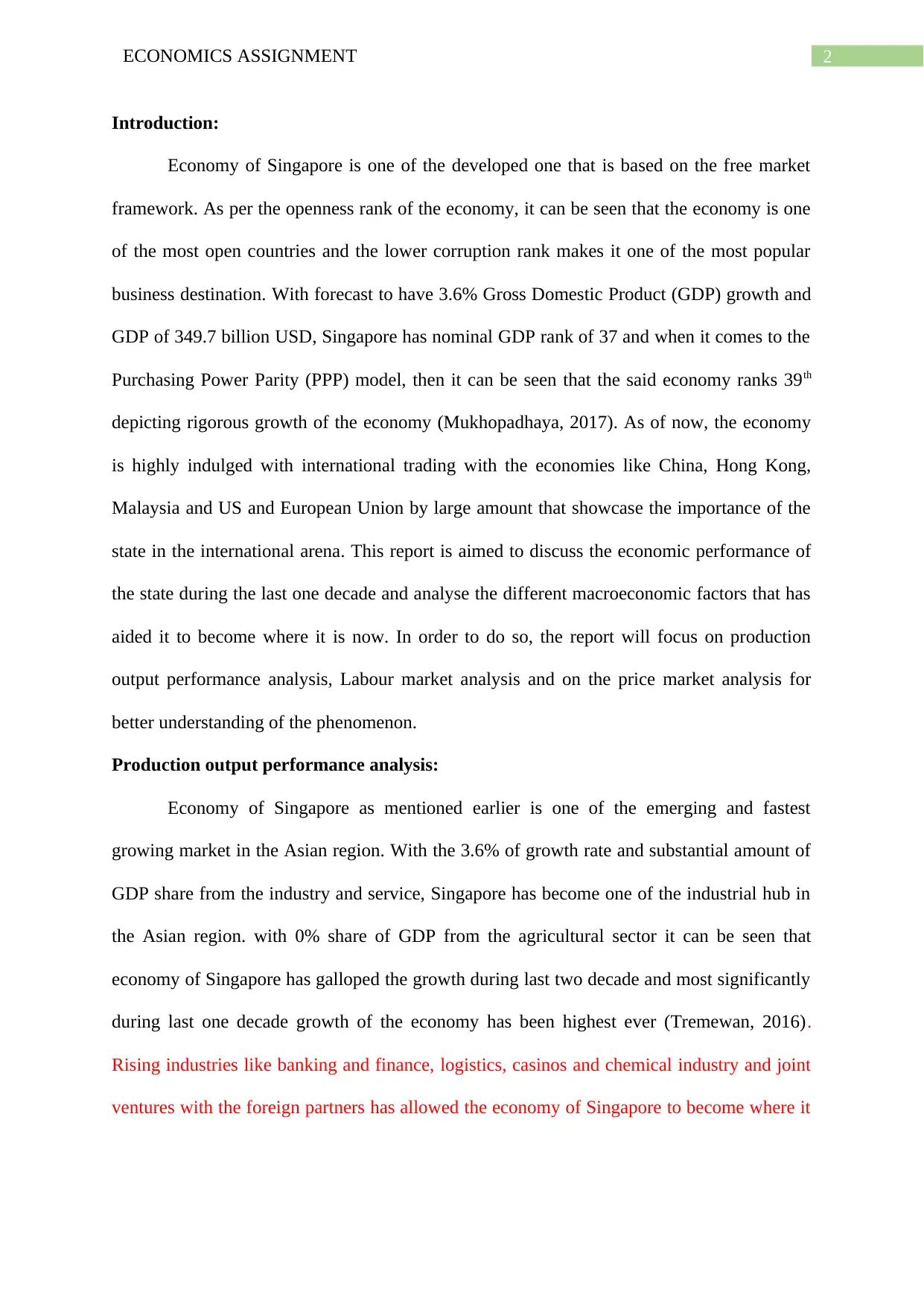
2ECONOMICS ASSIGNMENT
Introduction:
Economy of Singapore is one of the developed one that is based on the free market
framework. As per the openness rank of the economy, it can be seen that the economy is one
of the most open countries and the lower corruption rank makes it one of the most popular
business destination. With forecast to have 3.6% Gross Domestic Product (GDP) growth and
GDP of 349.7 billion USD, Singapore has nominal GDP rank of 37 and when it comes to the
Purchasing Power Parity (PPP) model, then it can be seen that the said economy ranks 39th
depicting rigorous growth of the economy (Mukhopadhaya, 2017). As of now, the economy
is highly indulged with international trading with the economies like China, Hong Kong,
Malaysia and US and European Union by large amount that showcase the importance of the
state in the international arena. This report is aimed to discuss the economic performance of
the state during the last one decade and analyse the different macroeconomic factors that has
aided it to become where it is now. In order to do so, the report will focus on production
output performance analysis, Labour market analysis and on the price market analysis for
better understanding of the phenomenon.
Production output performance analysis:
Economy of Singapore as mentioned earlier is one of the emerging and fastest
growing market in the Asian region. With the 3.6% of growth rate and substantial amount of
GDP share from the industry and service, Singapore has become one of the industrial hub in
the Asian region. with 0% share of GDP from the agricultural sector it can be seen that
economy of Singapore has galloped the growth during last two decade and most significantly
during last one decade growth of the economy has been highest ever (Tremewan, 2016).
Rising industries like banking and finance, logistics, casinos and chemical industry and joint
ventures with the foreign partners has allowed the economy of Singapore to become where it
Introduction:
Economy of Singapore is one of the developed one that is based on the free market
framework. As per the openness rank of the economy, it can be seen that the economy is one
of the most open countries and the lower corruption rank makes it one of the most popular
business destination. With forecast to have 3.6% Gross Domestic Product (GDP) growth and
GDP of 349.7 billion USD, Singapore has nominal GDP rank of 37 and when it comes to the
Purchasing Power Parity (PPP) model, then it can be seen that the said economy ranks 39th
depicting rigorous growth of the economy (Mukhopadhaya, 2017). As of now, the economy
is highly indulged with international trading with the economies like China, Hong Kong,
Malaysia and US and European Union by large amount that showcase the importance of the
state in the international arena. This report is aimed to discuss the economic performance of
the state during the last one decade and analyse the different macroeconomic factors that has
aided it to become where it is now. In order to do so, the report will focus on production
output performance analysis, Labour market analysis and on the price market analysis for
better understanding of the phenomenon.
Production output performance analysis:
Economy of Singapore as mentioned earlier is one of the emerging and fastest
growing market in the Asian region. With the 3.6% of growth rate and substantial amount of
GDP share from the industry and service, Singapore has become one of the industrial hub in
the Asian region. with 0% share of GDP from the agricultural sector it can be seen that
economy of Singapore has galloped the growth during last two decade and most significantly
during last one decade growth of the economy has been highest ever (Tremewan, 2016).
Rising industries like banking and finance, logistics, casinos and chemical industry and joint
ventures with the foreign partners has allowed the economy of Singapore to become where it
⊘ This is a preview!⊘
Do you want full access?
Subscribe today to unlock all pages.

Trusted by 1+ million students worldwide
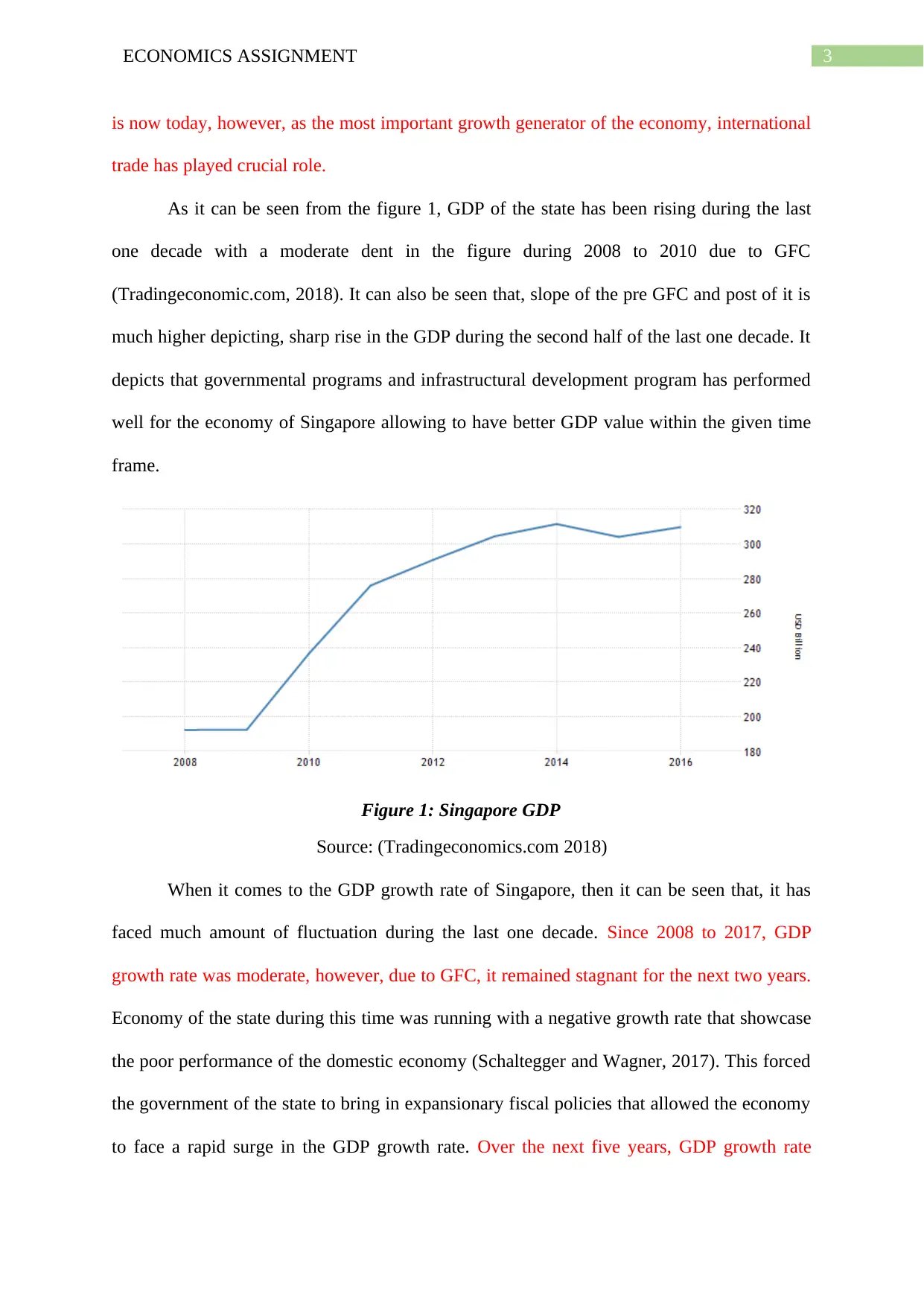
3ECONOMICS ASSIGNMENT
is now today, however, as the most important growth generator of the economy, international
trade has played crucial role.
As it can be seen from the figure 1, GDP of the state has been rising during the last
one decade with a moderate dent in the figure during 2008 to 2010 due to GFC
(Tradingeconomic.com, 2018). It can also be seen that, slope of the pre GFC and post of it is
much higher depicting, sharp rise in the GDP during the second half of the last one decade. It
depicts that governmental programs and infrastructural development program has performed
well for the economy of Singapore allowing to have better GDP value within the given time
frame.
Figure 1: Singapore GDP
Source: (Tradingeconomics.com 2018)
When it comes to the GDP growth rate of Singapore, then it can be seen that, it has
faced much amount of fluctuation during the last one decade. Since 2008 to 2017, GDP
growth rate was moderate, however, due to GFC, it remained stagnant for the next two years.
Economy of the state during this time was running with a negative growth rate that showcase
the poor performance of the domestic economy (Schaltegger and Wagner, 2017). This forced
the government of the state to bring in expansionary fiscal policies that allowed the economy
to face a rapid surge in the GDP growth rate. Over the next five years, GDP growth rate
is now today, however, as the most important growth generator of the economy, international
trade has played crucial role.
As it can be seen from the figure 1, GDP of the state has been rising during the last
one decade with a moderate dent in the figure during 2008 to 2010 due to GFC
(Tradingeconomic.com, 2018). It can also be seen that, slope of the pre GFC and post of it is
much higher depicting, sharp rise in the GDP during the second half of the last one decade. It
depicts that governmental programs and infrastructural development program has performed
well for the economy of Singapore allowing to have better GDP value within the given time
frame.
Figure 1: Singapore GDP
Source: (Tradingeconomics.com 2018)
When it comes to the GDP growth rate of Singapore, then it can be seen that, it has
faced much amount of fluctuation during the last one decade. Since 2008 to 2017, GDP
growth rate was moderate, however, due to GFC, it remained stagnant for the next two years.
Economy of the state during this time was running with a negative growth rate that showcase
the poor performance of the domestic economy (Schaltegger and Wagner, 2017). This forced
the government of the state to bring in expansionary fiscal policies that allowed the economy
to face a rapid surge in the GDP growth rate. Over the next five years, GDP growth rate
Paraphrase This Document
Need a fresh take? Get an instant paraphrase of this document with our AI Paraphraser
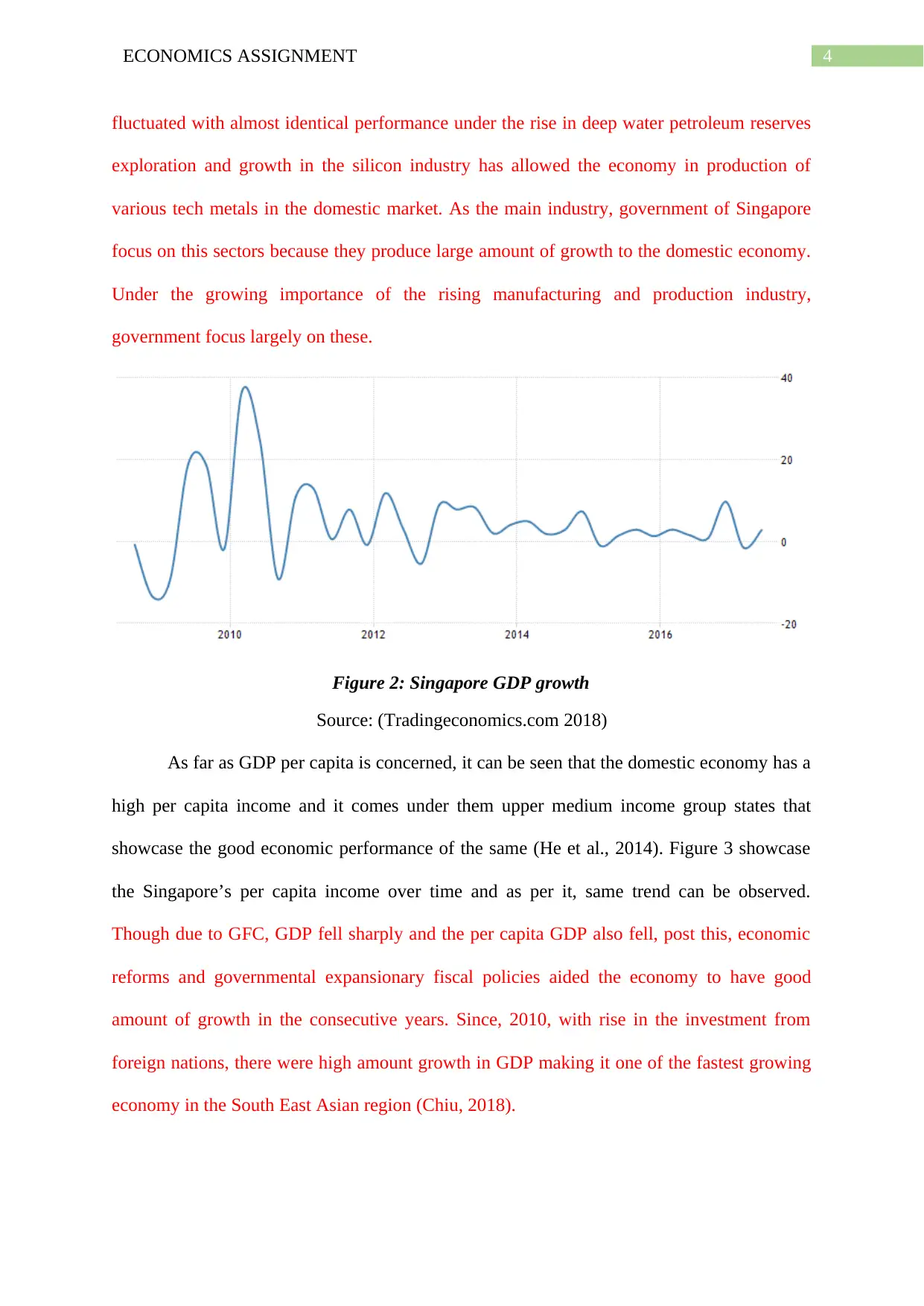
4ECONOMICS ASSIGNMENT
fluctuated with almost identical performance under the rise in deep water petroleum reserves
exploration and growth in the silicon industry has allowed the economy in production of
various tech metals in the domestic market. As the main industry, government of Singapore
focus on this sectors because they produce large amount of growth to the domestic economy.
Under the growing importance of the rising manufacturing and production industry,
government focus largely on these.
Figure 2: Singapore GDP growth
Source: (Tradingeconomics.com 2018)
As far as GDP per capita is concerned, it can be seen that the domestic economy has a
high per capita income and it comes under them upper medium income group states that
showcase the good economic performance of the same (He et al., 2014). Figure 3 showcase
the Singapore’s per capita income over time and as per it, same trend can be observed.
Though due to GFC, GDP fell sharply and the per capita GDP also fell, post this, economic
reforms and governmental expansionary fiscal policies aided the economy to have good
amount of growth in the consecutive years. Since, 2010, with rise in the investment from
foreign nations, there were high amount growth in GDP making it one of the fastest growing
economy in the South East Asian region (Chiu, 2018).
fluctuated with almost identical performance under the rise in deep water petroleum reserves
exploration and growth in the silicon industry has allowed the economy in production of
various tech metals in the domestic market. As the main industry, government of Singapore
focus on this sectors because they produce large amount of growth to the domestic economy.
Under the growing importance of the rising manufacturing and production industry,
government focus largely on these.
Figure 2: Singapore GDP growth
Source: (Tradingeconomics.com 2018)
As far as GDP per capita is concerned, it can be seen that the domestic economy has a
high per capita income and it comes under them upper medium income group states that
showcase the good economic performance of the same (He et al., 2014). Figure 3 showcase
the Singapore’s per capita income over time and as per it, same trend can be observed.
Though due to GFC, GDP fell sharply and the per capita GDP also fell, post this, economic
reforms and governmental expansionary fiscal policies aided the economy to have good
amount of growth in the consecutive years. Since, 2010, with rise in the investment from
foreign nations, there were high amount growth in GDP making it one of the fastest growing
economy in the South East Asian region (Chiu, 2018).
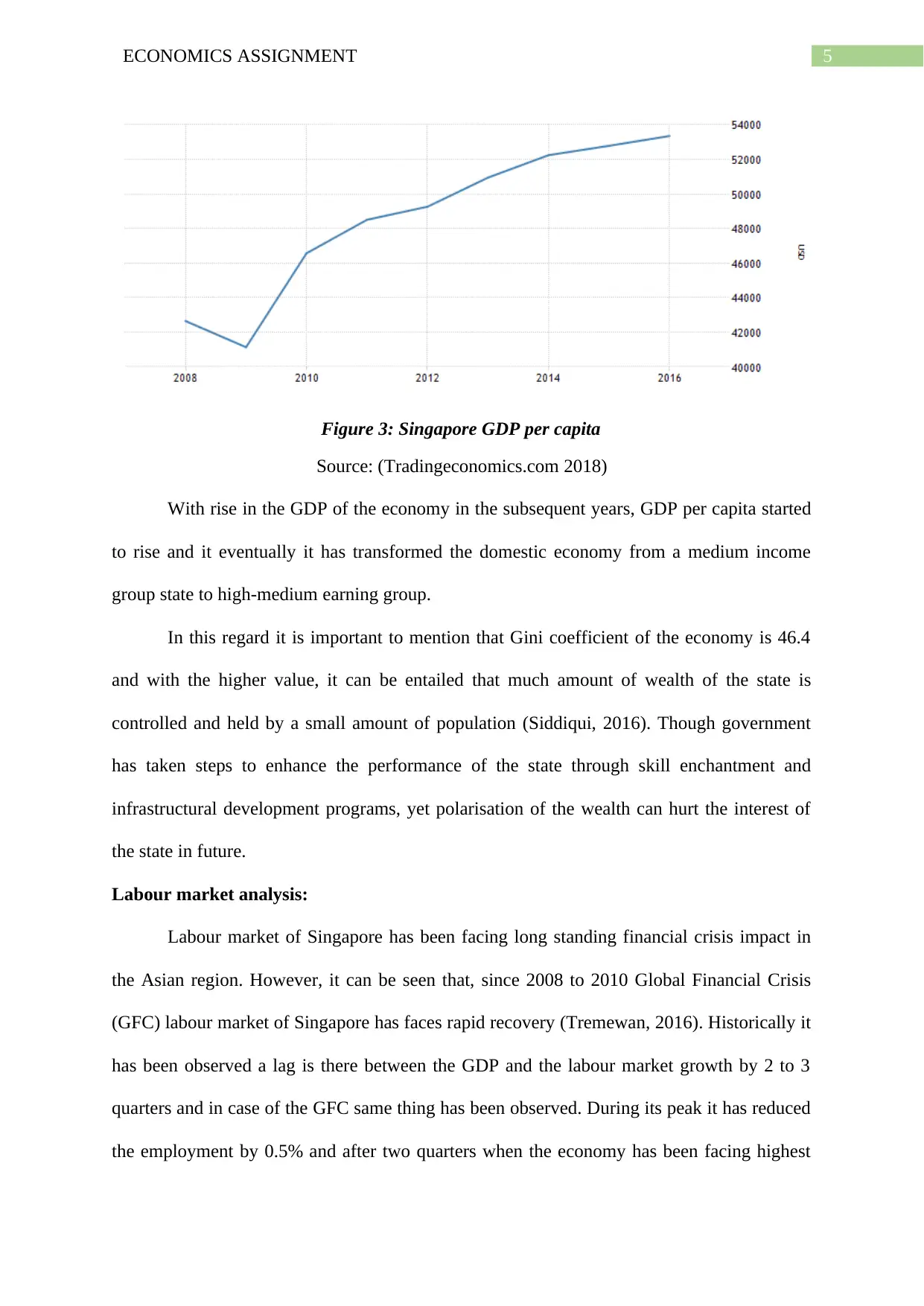
5ECONOMICS ASSIGNMENT
Figure 3: Singapore GDP per capita
Source: (Tradingeconomics.com 2018)
With rise in the GDP of the economy in the subsequent years, GDP per capita started
to rise and it eventually it has transformed the domestic economy from a medium income
group state to high-medium earning group.
In this regard it is important to mention that Gini coefficient of the economy is 46.4
and with the higher value, it can be entailed that much amount of wealth of the state is
controlled and held by a small amount of population (Siddiqui, 2016). Though government
has taken steps to enhance the performance of the state through skill enchantment and
infrastructural development programs, yet polarisation of the wealth can hurt the interest of
the state in future.
Labour market analysis:
Labour market of Singapore has been facing long standing financial crisis impact in
the Asian region. However, it can be seen that, since 2008 to 2010 Global Financial Crisis
(GFC) labour market of Singapore has faces rapid recovery (Tremewan, 2016). Historically it
has been observed a lag is there between the GDP and the labour market growth by 2 to 3
quarters and in case of the GFC same thing has been observed. During its peak it has reduced
the employment by 0.5% and after two quarters when the economy has been facing highest
Figure 3: Singapore GDP per capita
Source: (Tradingeconomics.com 2018)
With rise in the GDP of the economy in the subsequent years, GDP per capita started
to rise and it eventually it has transformed the domestic economy from a medium income
group state to high-medium earning group.
In this regard it is important to mention that Gini coefficient of the economy is 46.4
and with the higher value, it can be entailed that much amount of wealth of the state is
controlled and held by a small amount of population (Siddiqui, 2016). Though government
has taken steps to enhance the performance of the state through skill enchantment and
infrastructural development programs, yet polarisation of the wealth can hurt the interest of
the state in future.
Labour market analysis:
Labour market of Singapore has been facing long standing financial crisis impact in
the Asian region. However, it can be seen that, since 2008 to 2010 Global Financial Crisis
(GFC) labour market of Singapore has faces rapid recovery (Tremewan, 2016). Historically it
has been observed a lag is there between the GDP and the labour market growth by 2 to 3
quarters and in case of the GFC same thing has been observed. During its peak it has reduced
the employment by 0.5% and after two quarters when the economy has been facing highest
⊘ This is a preview!⊘
Do you want full access?
Subscribe today to unlock all pages.

Trusted by 1+ million students worldwide
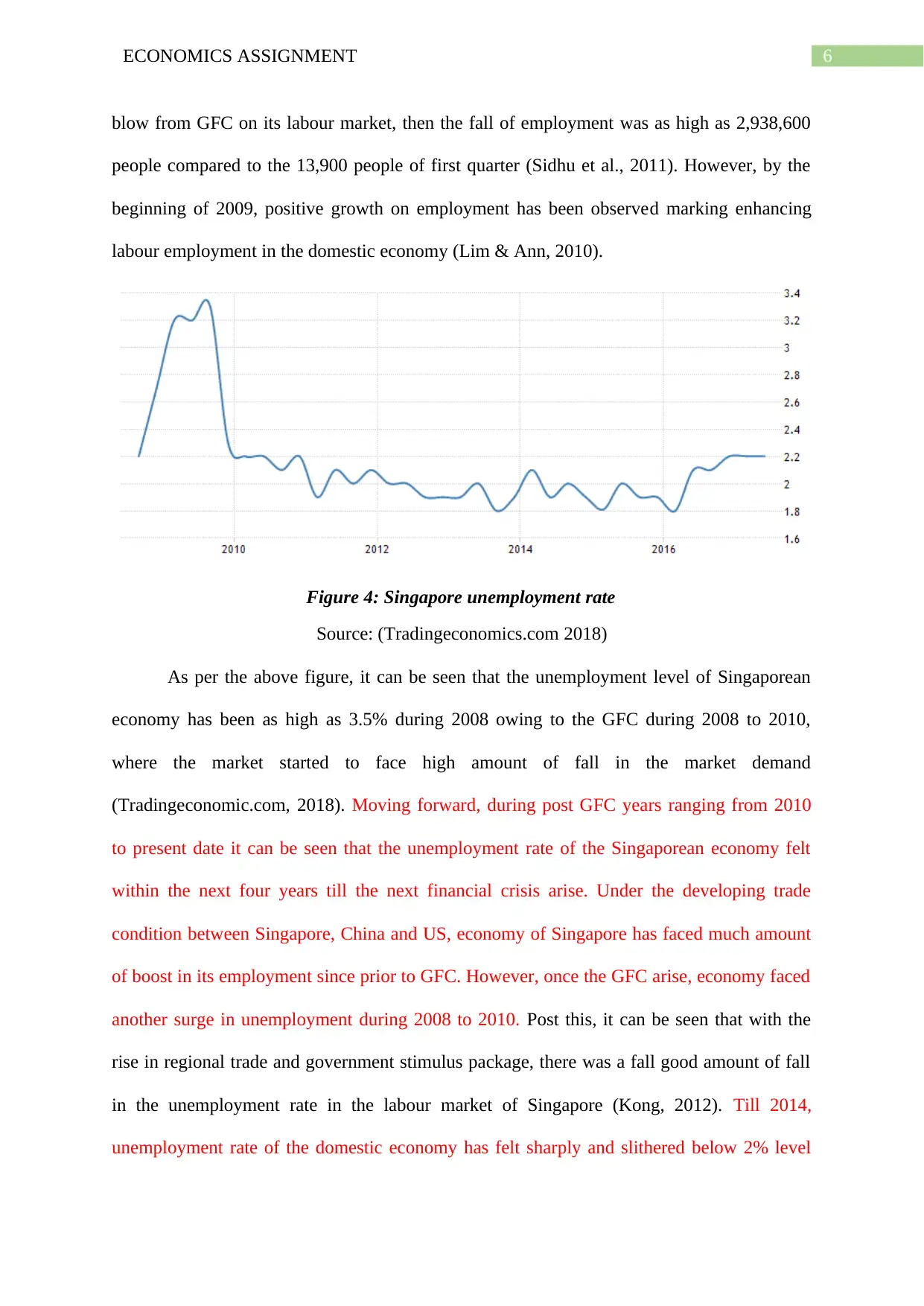
6ECONOMICS ASSIGNMENT
blow from GFC on its labour market, then the fall of employment was as high as 2,938,600
people compared to the 13,900 people of first quarter (Sidhu et al., 2011). However, by the
beginning of 2009, positive growth on employment has been observed marking enhancing
labour employment in the domestic economy (Lim & Ann, 2010).
Figure 4: Singapore unemployment rate
Source: (Tradingeconomics.com 2018)
As per the above figure, it can be seen that the unemployment level of Singaporean
economy has been as high as 3.5% during 2008 owing to the GFC during 2008 to 2010,
where the market started to face high amount of fall in the market demand
(Tradingeconomic.com, 2018). Moving forward, during post GFC years ranging from 2010
to present date it can be seen that the unemployment rate of the Singaporean economy felt
within the next four years till the next financial crisis arise. Under the developing trade
condition between Singapore, China and US, economy of Singapore has faced much amount
of boost in its employment since prior to GFC. However, once the GFC arise, economy faced
another surge in unemployment during 2008 to 2010. Post this, it can be seen that with the
rise in regional trade and government stimulus package, there was a fall good amount of fall
in the unemployment rate in the labour market of Singapore (Kong, 2012). Till 2014,
unemployment rate of the domestic economy has felt sharply and slithered below 2% level
blow from GFC on its labour market, then the fall of employment was as high as 2,938,600
people compared to the 13,900 people of first quarter (Sidhu et al., 2011). However, by the
beginning of 2009, positive growth on employment has been observed marking enhancing
labour employment in the domestic economy (Lim & Ann, 2010).
Figure 4: Singapore unemployment rate
Source: (Tradingeconomics.com 2018)
As per the above figure, it can be seen that the unemployment level of Singaporean
economy has been as high as 3.5% during 2008 owing to the GFC during 2008 to 2010,
where the market started to face high amount of fall in the market demand
(Tradingeconomic.com, 2018). Moving forward, during post GFC years ranging from 2010
to present date it can be seen that the unemployment rate of the Singaporean economy felt
within the next four years till the next financial crisis arise. Under the developing trade
condition between Singapore, China and US, economy of Singapore has faced much amount
of boost in its employment since prior to GFC. However, once the GFC arise, economy faced
another surge in unemployment during 2008 to 2010. Post this, it can be seen that with the
rise in regional trade and government stimulus package, there was a fall good amount of fall
in the unemployment rate in the labour market of Singapore (Kong, 2012). Till 2014,
unemployment rate of the domestic economy has felt sharply and slithered below 2% level
Paraphrase This Document
Need a fresh take? Get an instant paraphrase of this document with our AI Paraphraser
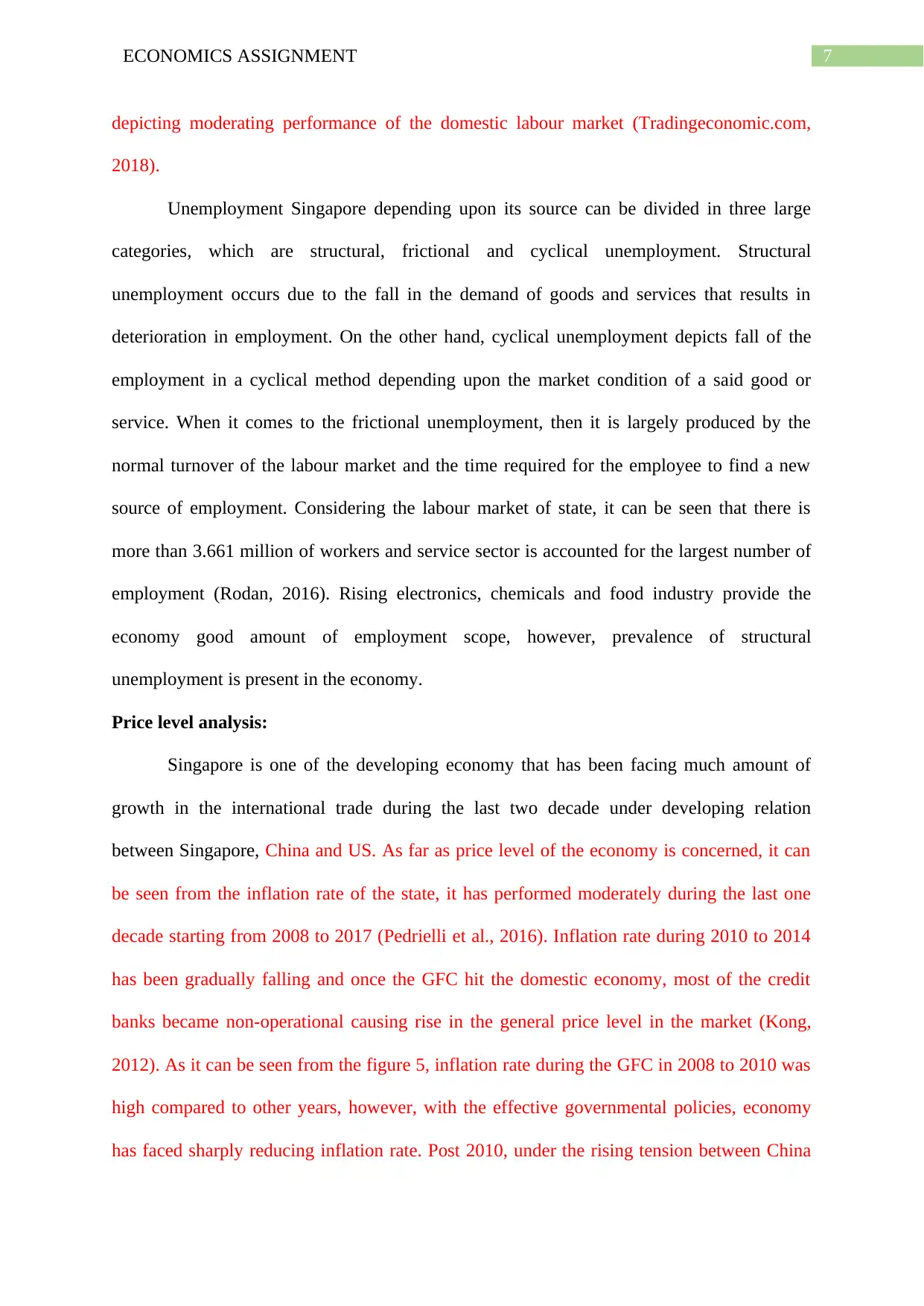
7ECONOMICS ASSIGNMENT
depicting moderating performance of the domestic labour market (Tradingeconomic.com,
2018).
Unemployment Singapore depending upon its source can be divided in three large
categories, which are structural, frictional and cyclical unemployment. Structural
unemployment occurs due to the fall in the demand of goods and services that results in
deterioration in employment. On the other hand, cyclical unemployment depicts fall of the
employment in a cyclical method depending upon the market condition of a said good or
service. When it comes to the frictional unemployment, then it is largely produced by the
normal turnover of the labour market and the time required for the employee to find a new
source of employment. Considering the labour market of state, it can be seen that there is
more than 3.661 million of workers and service sector is accounted for the largest number of
employment (Rodan, 2016). Rising electronics, chemicals and food industry provide the
economy good amount of employment scope, however, prevalence of structural
unemployment is present in the economy.
Price level analysis:
Singapore is one of the developing economy that has been facing much amount of
growth in the international trade during the last two decade under developing relation
between Singapore, China and US. As far as price level of the economy is concerned, it can
be seen from the inflation rate of the state, it has performed moderately during the last one
decade starting from 2008 to 2017 (Pedrielli et al., 2016). Inflation rate during 2010 to 2014
has been gradually falling and once the GFC hit the domestic economy, most of the credit
banks became non-operational causing rise in the general price level in the market (Kong,
2012). As it can be seen from the figure 5, inflation rate during the GFC in 2008 to 2010 was
high compared to other years, however, with the effective governmental policies, economy
has faced sharply reducing inflation rate. Post 2010, under the rising tension between China
depicting moderating performance of the domestic labour market (Tradingeconomic.com,
2018).
Unemployment Singapore depending upon its source can be divided in three large
categories, which are structural, frictional and cyclical unemployment. Structural
unemployment occurs due to the fall in the demand of goods and services that results in
deterioration in employment. On the other hand, cyclical unemployment depicts fall of the
employment in a cyclical method depending upon the market condition of a said good or
service. When it comes to the frictional unemployment, then it is largely produced by the
normal turnover of the labour market and the time required for the employee to find a new
source of employment. Considering the labour market of state, it can be seen that there is
more than 3.661 million of workers and service sector is accounted for the largest number of
employment (Rodan, 2016). Rising electronics, chemicals and food industry provide the
economy good amount of employment scope, however, prevalence of structural
unemployment is present in the economy.
Price level analysis:
Singapore is one of the developing economy that has been facing much amount of
growth in the international trade during the last two decade under developing relation
between Singapore, China and US. As far as price level of the economy is concerned, it can
be seen from the inflation rate of the state, it has performed moderately during the last one
decade starting from 2008 to 2017 (Pedrielli et al., 2016). Inflation rate during 2010 to 2014
has been gradually falling and once the GFC hit the domestic economy, most of the credit
banks became non-operational causing rise in the general price level in the market (Kong,
2012). As it can be seen from the figure 5, inflation rate during the GFC in 2008 to 2010 was
high compared to other years, however, with the effective governmental policies, economy
has faced sharply reducing inflation rate. Post 2010, under the rising tension between China
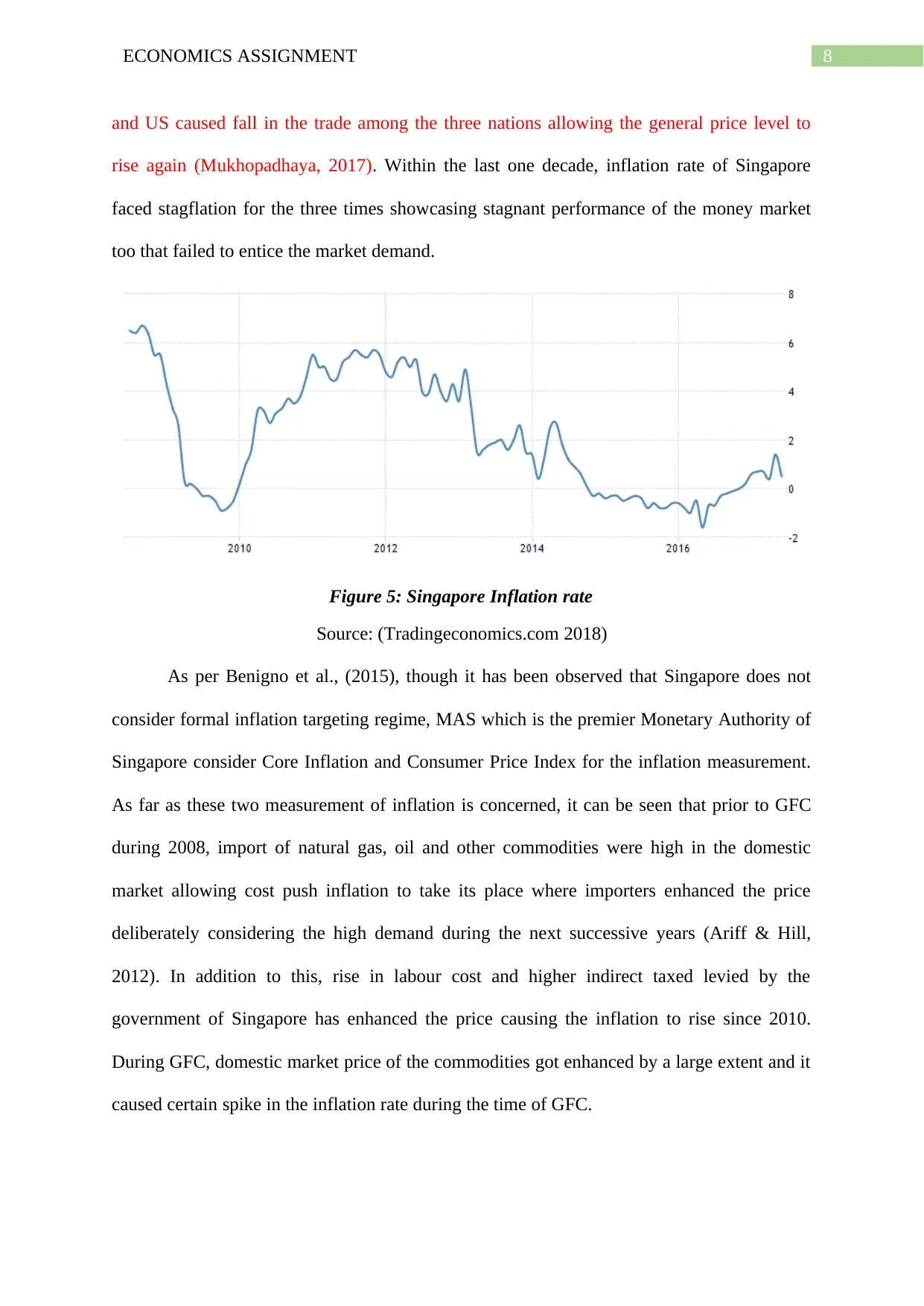
8ECONOMICS ASSIGNMENT
and US caused fall in the trade among the three nations allowing the general price level to
rise again (Mukhopadhaya, 2017). Within the last one decade, inflation rate of Singapore
faced stagflation for the three times showcasing stagnant performance of the money market
too that failed to entice the market demand.
Figure 5: Singapore Inflation rate
Source: (Tradingeconomics.com 2018)
As per Benigno et al., (2015), though it has been observed that Singapore does not
consider formal inflation targeting regime, MAS which is the premier Monetary Authority of
Singapore consider Core Inflation and Consumer Price Index for the inflation measurement.
As far as these two measurement of inflation is concerned, it can be seen that prior to GFC
during 2008, import of natural gas, oil and other commodities were high in the domestic
market allowing cost push inflation to take its place where importers enhanced the price
deliberately considering the high demand during the next successive years (Ariff & Hill,
2012). In addition to this, rise in labour cost and higher indirect taxed levied by the
government of Singapore has enhanced the price causing the inflation to rise since 2010.
During GFC, domestic market price of the commodities got enhanced by a large extent and it
caused certain spike in the inflation rate during the time of GFC.
and US caused fall in the trade among the three nations allowing the general price level to
rise again (Mukhopadhaya, 2017). Within the last one decade, inflation rate of Singapore
faced stagflation for the three times showcasing stagnant performance of the money market
too that failed to entice the market demand.
Figure 5: Singapore Inflation rate
Source: (Tradingeconomics.com 2018)
As per Benigno et al., (2015), though it has been observed that Singapore does not
consider formal inflation targeting regime, MAS which is the premier Monetary Authority of
Singapore consider Core Inflation and Consumer Price Index for the inflation measurement.
As far as these two measurement of inflation is concerned, it can be seen that prior to GFC
during 2008, import of natural gas, oil and other commodities were high in the domestic
market allowing cost push inflation to take its place where importers enhanced the price
deliberately considering the high demand during the next successive years (Ariff & Hill,
2012). In addition to this, rise in labour cost and higher indirect taxed levied by the
government of Singapore has enhanced the price causing the inflation to rise since 2010.
During GFC, domestic market price of the commodities got enhanced by a large extent and it
caused certain spike in the inflation rate during the time of GFC.
⊘ This is a preview!⊘
Do you want full access?
Subscribe today to unlock all pages.

Trusted by 1+ million students worldwide
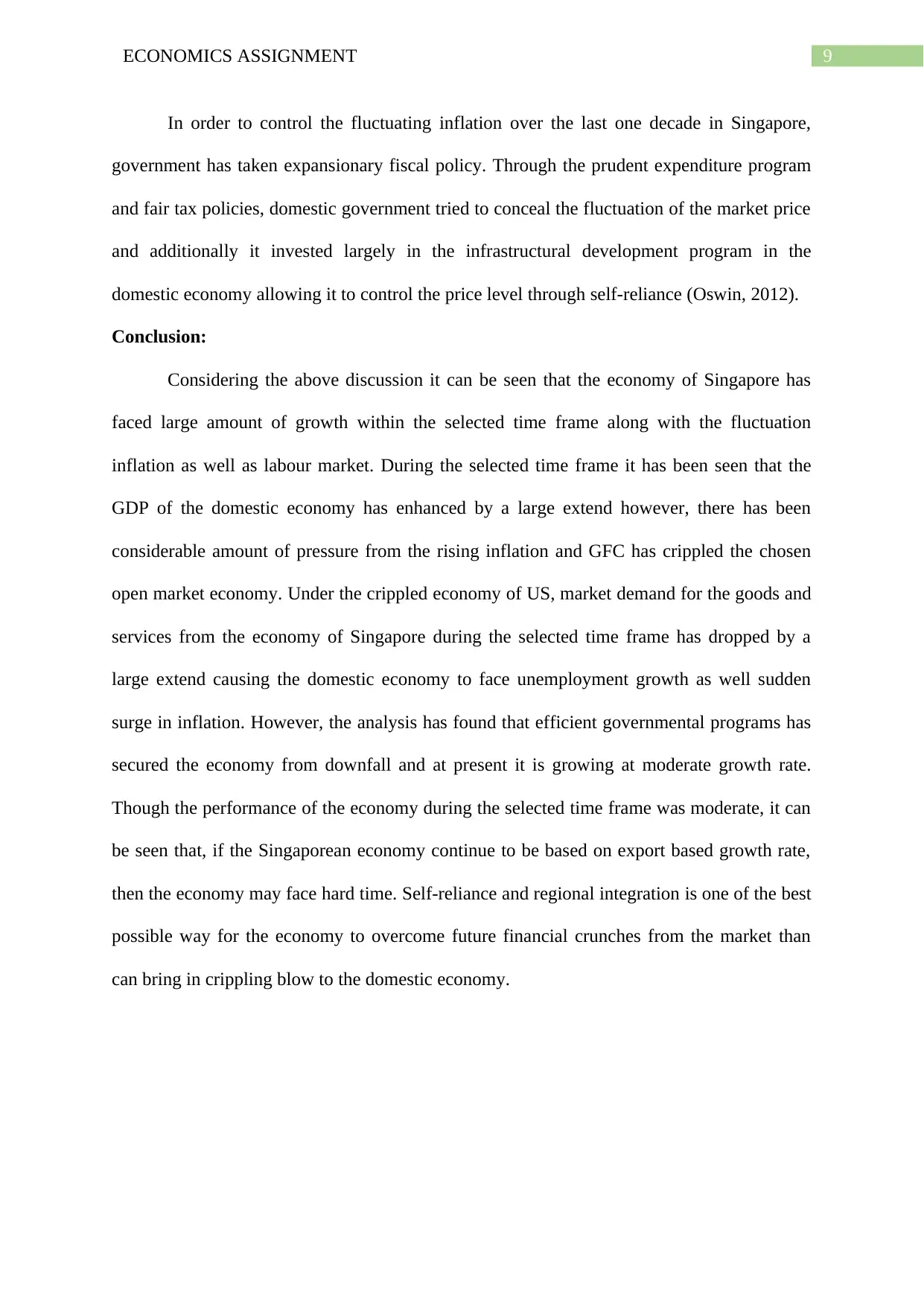
9ECONOMICS ASSIGNMENT
In order to control the fluctuating inflation over the last one decade in Singapore,
government has taken expansionary fiscal policy. Through the prudent expenditure program
and fair tax policies, domestic government tried to conceal the fluctuation of the market price
and additionally it invested largely in the infrastructural development program in the
domestic economy allowing it to control the price level through self-reliance (Oswin, 2012).
Conclusion:
Considering the above discussion it can be seen that the economy of Singapore has
faced large amount of growth within the selected time frame along with the fluctuation
inflation as well as labour market. During the selected time frame it has been seen that the
GDP of the domestic economy has enhanced by a large extend however, there has been
considerable amount of pressure from the rising inflation and GFC has crippled the chosen
open market economy. Under the crippled economy of US, market demand for the goods and
services from the economy of Singapore during the selected time frame has dropped by a
large extend causing the domestic economy to face unemployment growth as well sudden
surge in inflation. However, the analysis has found that efficient governmental programs has
secured the economy from downfall and at present it is growing at moderate growth rate.
Though the performance of the economy during the selected time frame was moderate, it can
be seen that, if the Singaporean economy continue to be based on export based growth rate,
then the economy may face hard time. Self-reliance and regional integration is one of the best
possible way for the economy to overcome future financial crunches from the market than
can bring in crippling blow to the domestic economy.
In order to control the fluctuating inflation over the last one decade in Singapore,
government has taken expansionary fiscal policy. Through the prudent expenditure program
and fair tax policies, domestic government tried to conceal the fluctuation of the market price
and additionally it invested largely in the infrastructural development program in the
domestic economy allowing it to control the price level through self-reliance (Oswin, 2012).
Conclusion:
Considering the above discussion it can be seen that the economy of Singapore has
faced large amount of growth within the selected time frame along with the fluctuation
inflation as well as labour market. During the selected time frame it has been seen that the
GDP of the domestic economy has enhanced by a large extend however, there has been
considerable amount of pressure from the rising inflation and GFC has crippled the chosen
open market economy. Under the crippled economy of US, market demand for the goods and
services from the economy of Singapore during the selected time frame has dropped by a
large extend causing the domestic economy to face unemployment growth as well sudden
surge in inflation. However, the analysis has found that efficient governmental programs has
secured the economy from downfall and at present it is growing at moderate growth rate.
Though the performance of the economy during the selected time frame was moderate, it can
be seen that, if the Singaporean economy continue to be based on export based growth rate,
then the economy may face hard time. Self-reliance and regional integration is one of the best
possible way for the economy to overcome future financial crunches from the market than
can bring in crippling blow to the domestic economy.
Paraphrase This Document
Need a fresh take? Get an instant paraphrase of this document with our AI Paraphraser
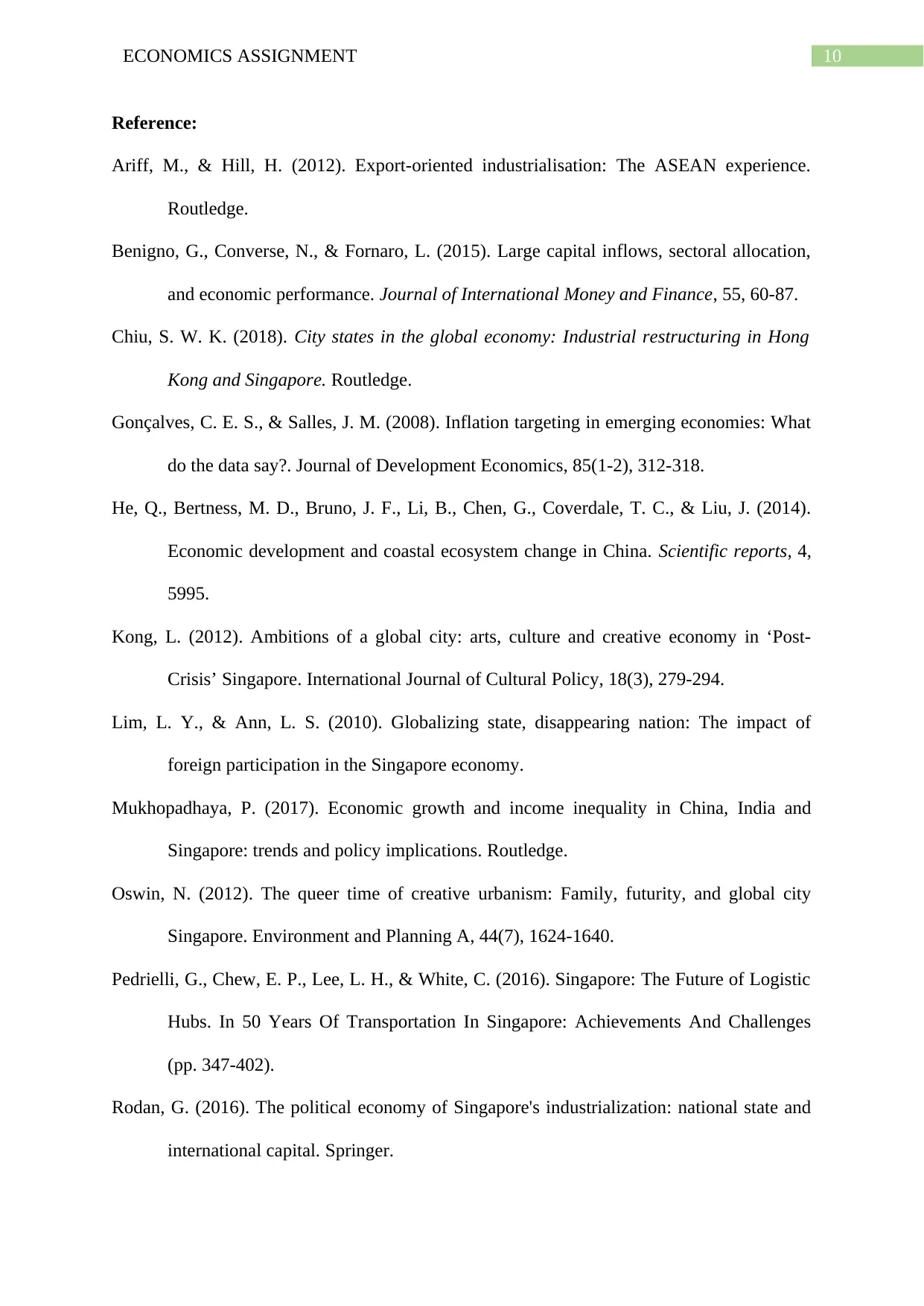
10ECONOMICS ASSIGNMENT
Reference:
Ariff, M., & Hill, H. (2012). Export-oriented industrialisation: The ASEAN experience.
Routledge.
Benigno, G., Converse, N., & Fornaro, L. (2015). Large capital inflows, sectoral allocation,
and economic performance. Journal of International Money and Finance, 55, 60-87.
Chiu, S. W. K. (2018). City states in the global economy: Industrial restructuring in Hong
Kong and Singapore. Routledge.
Gonçalves, C. E. S., & Salles, J. M. (2008). Inflation targeting in emerging economies: What
do the data say?. Journal of Development Economics, 85(1-2), 312-318.
He, Q., Bertness, M. D., Bruno, J. F., Li, B., Chen, G., Coverdale, T. C., & Liu, J. (2014).
Economic development and coastal ecosystem change in China. Scientific reports, 4,
5995.
Kong, L. (2012). Ambitions of a global city: arts, culture and creative economy in ‘Post-
Crisis’ Singapore. International Journal of Cultural Policy, 18(3), 279-294.
Lim, L. Y., & Ann, L. S. (2010). Globalizing state, disappearing nation: The impact of
foreign participation in the Singapore economy.
Mukhopadhaya, P. (2017). Economic growth and income inequality in China, India and
Singapore: trends and policy implications. Routledge.
Oswin, N. (2012). The queer time of creative urbanism: Family, futurity, and global city
Singapore. Environment and Planning A, 44(7), 1624-1640.
Pedrielli, G., Chew, E. P., Lee, L. H., & White, C. (2016). Singapore: The Future of Logistic
Hubs. In 50 Years Of Transportation In Singapore: Achievements And Challenges
(pp. 347-402).
Rodan, G. (2016). The political economy of Singapore's industrialization: national state and
international capital. Springer.
Reference:
Ariff, M., & Hill, H. (2012). Export-oriented industrialisation: The ASEAN experience.
Routledge.
Benigno, G., Converse, N., & Fornaro, L. (2015). Large capital inflows, sectoral allocation,
and economic performance. Journal of International Money and Finance, 55, 60-87.
Chiu, S. W. K. (2018). City states in the global economy: Industrial restructuring in Hong
Kong and Singapore. Routledge.
Gonçalves, C. E. S., & Salles, J. M. (2008). Inflation targeting in emerging economies: What
do the data say?. Journal of Development Economics, 85(1-2), 312-318.
He, Q., Bertness, M. D., Bruno, J. F., Li, B., Chen, G., Coverdale, T. C., & Liu, J. (2014).
Economic development and coastal ecosystem change in China. Scientific reports, 4,
5995.
Kong, L. (2012). Ambitions of a global city: arts, culture and creative economy in ‘Post-
Crisis’ Singapore. International Journal of Cultural Policy, 18(3), 279-294.
Lim, L. Y., & Ann, L. S. (2010). Globalizing state, disappearing nation: The impact of
foreign participation in the Singapore economy.
Mukhopadhaya, P. (2017). Economic growth and income inequality in China, India and
Singapore: trends and policy implications. Routledge.
Oswin, N. (2012). The queer time of creative urbanism: Family, futurity, and global city
Singapore. Environment and Planning A, 44(7), 1624-1640.
Pedrielli, G., Chew, E. P., Lee, L. H., & White, C. (2016). Singapore: The Future of Logistic
Hubs. In 50 Years Of Transportation In Singapore: Achievements And Challenges
(pp. 347-402).
Rodan, G. (2016). The political economy of Singapore's industrialization: national state and
international capital. Springer.
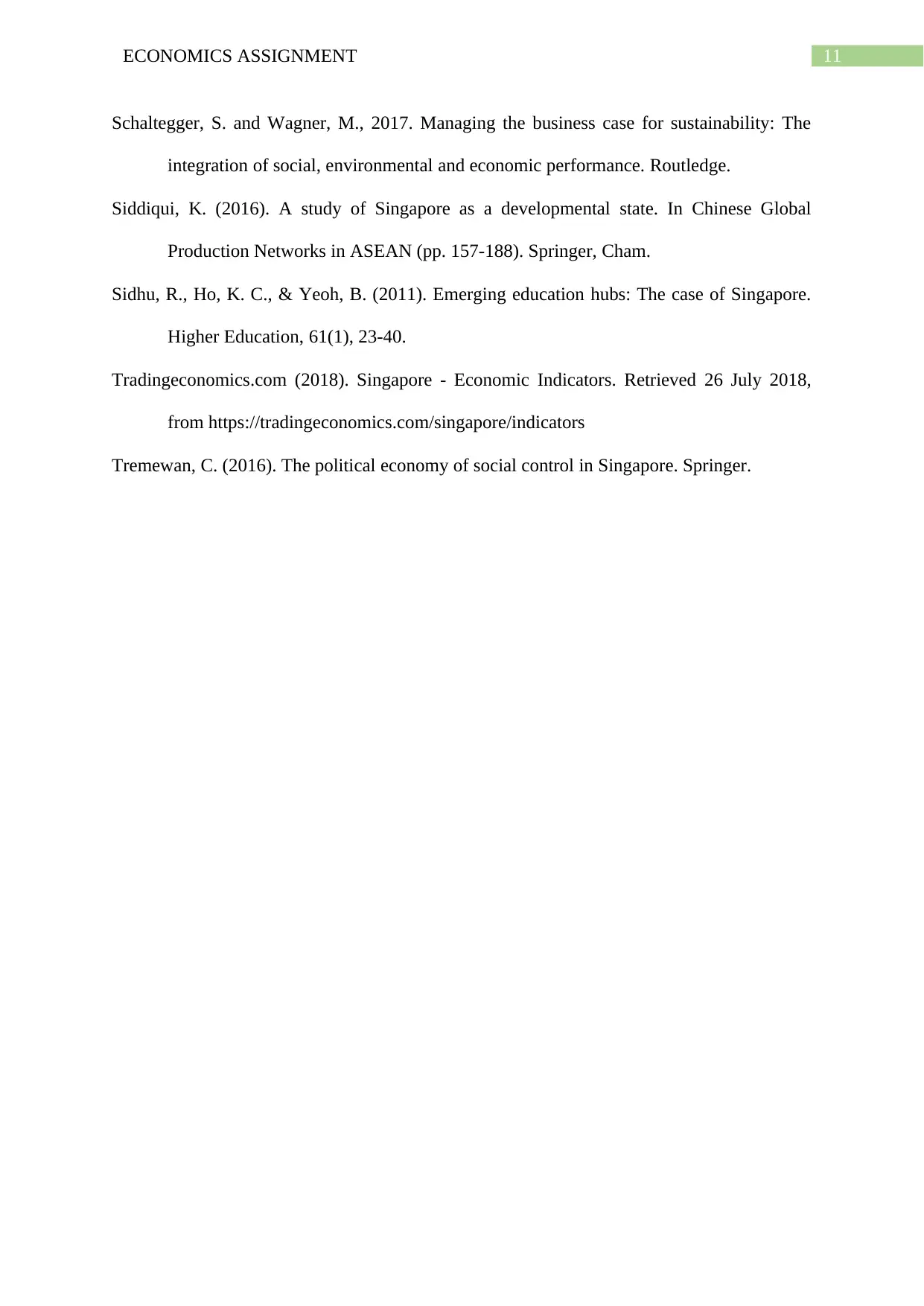
11ECONOMICS ASSIGNMENT
Schaltegger, S. and Wagner, M., 2017. Managing the business case for sustainability: The
integration of social, environmental and economic performance. Routledge.
Siddiqui, K. (2016). A study of Singapore as a developmental state. In Chinese Global
Production Networks in ASEAN (pp. 157-188). Springer, Cham.
Sidhu, R., Ho, K. C., & Yeoh, B. (2011). Emerging education hubs: The case of Singapore.
Higher Education, 61(1), 23-40.
Tradingeconomics.com (2018). Singapore - Economic Indicators. Retrieved 26 July 2018,
from https://tradingeconomics.com/singapore/indicators
Tremewan, C. (2016). The political economy of social control in Singapore. Springer.
Schaltegger, S. and Wagner, M., 2017. Managing the business case for sustainability: The
integration of social, environmental and economic performance. Routledge.
Siddiqui, K. (2016). A study of Singapore as a developmental state. In Chinese Global
Production Networks in ASEAN (pp. 157-188). Springer, Cham.
Sidhu, R., Ho, K. C., & Yeoh, B. (2011). Emerging education hubs: The case of Singapore.
Higher Education, 61(1), 23-40.
Tradingeconomics.com (2018). Singapore - Economic Indicators. Retrieved 26 July 2018,
from https://tradingeconomics.com/singapore/indicators
Tremewan, C. (2016). The political economy of social control in Singapore. Springer.
⊘ This is a preview!⊘
Do you want full access?
Subscribe today to unlock all pages.

Trusted by 1+ million students worldwide
1 out of 12
Related Documents
Your All-in-One AI-Powered Toolkit for Academic Success.
+13062052269
info@desklib.com
Available 24*7 on WhatsApp / Email
![[object Object]](/_next/static/media/star-bottom.7253800d.svg)
Unlock your academic potential
Copyright © 2020–2025 A2Z Services. All Rights Reserved. Developed and managed by ZUCOL.




